Related Research Articles

Characidae, the characids or characins is a family of freshwater subtropical and tropical fish, belonging to the order Characiformes. The name "characins" is the historical one, but scientists today tend to prefer "characids" to reflect their status as a by and large monophyletic group at family rank. To arrive there, this family has undergone much systematic and taxonomic change. Among those fishes that remain in the Characidae for the time being are the tetras, comprising the very similar genera Hemigrammus and Hyphessobrycon, as well as a few related forms such as the cave and neon tetras. Fish of this family are important as food and also include popular aquarium fish species.
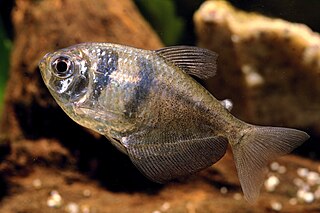
The black tetra, also known as the black skirt tetra, petticoat tetra, high-fin black skirt tetra, black widow tetra and blackamoor, is a freshwater fish of the characin family (Characidae). It is native to the Paraguay River basin of south-central Brazil, Paraguay and northeast Argentina, but there are also populations in the upper Paraná and Paraíba do Sul Rivers that likely were introduced. It was formerly reported from the Guapore River, but this population is part of G. flaviolimai, which is found throughout the Madeira River basin and was described in 2015. The black tetra is often kept in aquariums.

The cardinal tetra is a freshwater fish of the family Characidae of order Characiformes. It is native to the upper Orinoco and Negro Rivers in South America. Growing to about 3 cm (1.2 in) total length, the cardinal tetra has the striking iridescent blue line characteristic of the genus Paracheirodon laterally bisecting the fish, with the body below this line being vivid red in color, hence the name "cardinal tetra". The cardinal tetra's appearance is similar to that of the closely related neon tetra, with which it is often confused; the neon's red coloration extends only about halfway to the nose, and the neon's blue stripe is a less vibrant blue.

Tetra is the common name of many small freshwater characiform fishes. Tetras come from Africa, Central America, and South America, belonging to the biological family Characidae and to its former subfamilies Alestidae and Lebiasinidae. The Characidae are distinguished from other fish by the presence of a small adipose fin between the dorsal and caudal fins. Many of these, such as the neon tetra, are brightly colored and easy to keep in captivity. Consequently, they are extremely popular for home aquaria.
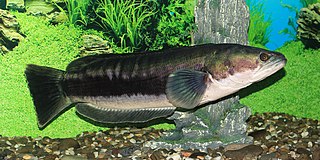
Channa is a genus of predatory fish in the family Channidae, commonly known as snakeheads, native to freshwater habitats in Asia. This genus contains about 50 scientifically described species. The genus has a wide natural distribution extending from Iraq in the west, to Indonesia and China in the east, and parts of Siberia in the Far East. A particularly high richness of species exists in Myanmar (Burma) and northeastern India, and many Channa species live nowhere else. In contrast, a few widespread species have been introduced to several regions outside their natural range, where they often become invasive. The large and medium-sized Channa species are among the most common staple food fish in several Asian countries, and they are extensively cultured. Apart from their importance as a food fish, snakeheads are consumed in some regions as a traditional medicine for wound healing and reducing postoperative pain and discomfort, and collected for the international aquarium pet trade.

Hyphessobrycon is a genus of freshwater fish in the family Characidae. These species are among the fishes known as tetras. The genus is distributed in the Neotropical realm from southern Mexico to Río de la Plata in Argentina. Many of these species are native to South America; about six species are from Central America and a single species, H. compressus is from southern Mexico.

Channa bleheri is a species of dwarf snakehead that is endemic to the Brahmaputra River basin in the Indian states of Assam and Arunachal Pradesh. It is among the most colorful species of snakehead.

Dwarf snakehead is a term coined by aquarists to describe a group of Channa snakehead fishes growing to about 25 cm (10 in) maximum. They are found in freshwater habitats in South and Southeast Asia, and southern China.

Guaporé River is a river in western Brazil and northeastern Bolivia. It is 1,260 km (780 mi) long; 920 km (570 mi) of the river forms the border between Brazil and Bolivia.

The rummy-nose tetra is a species of tropical freshwater characin fish originating in South America, popular among fishkeepers as a tropical aquarium fish. One of many small tetras belonging to the same genus, it is on average 5 cm (2 in) long when fully grown. The fish is one of several very similar species including Hemigrammus bleheri, and Petitella georgiae, and it is possible that more recently collected specimens available in the aquarium trade are members of one or other of these similar species. The common name applied to most of these fishes is "rummy-nose tetra", though other common names are in circulation.
Bleher's rainbowfish is a species of rainbowfish in the subfamily Melanotaeniinae.

The ember tetra is a freshwater fish of the characin family of order Characiformes. It is native to the Araguaia River basin of Brazil and was discovered in 1987 and named in honor of the fish explorer Heiko Bleher's mother.

The gold tetra is a species of small freshwater fish in the family Characidae native to lowland South America, where they are abundant in coastal floodplains. Their name comes from a powdery golden tint on their body that is thought to be caused by internal parasites. Gold tetras are peaceful, hardy, schooling community fish. Gold tetras have been successfully bred in captivity.

Hemigrammus is a genus of freshwater fish in the family Characidae native to South America and commonly seen in the aquarium trade. These are medium-small tetras where the largest species reach up to around 11 cm (4.3 in).
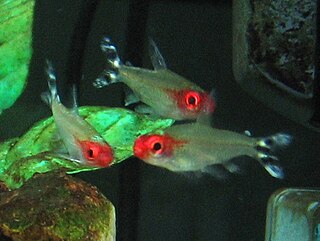
Hemigrammus bleheri is a species of characin found in Amazon Basin in Brazil and Peru. One of three species called rummy-nose tetra, but is also called firehead tetra according to FishBase. Reaching a standard length of 2" (5 cm) it is a common species found in the aquarium trade although often potentially hybridised with the other collective rummy-nose tetra species Hemigrammus rhodostomus and Petitella georgiae; the false rummy-nose tetra.

Melanotaeniinae the Australian rainbowfishes is a subfamily of the rainbowfishes of the family Melanotaeniidae. They are a group of small, colourful, freshwater fish found in northern and eastern Australia, New Guinea, islands in Cenderawasih Bay the Raja Ampat Islands in Indonesia and in Madagascar.
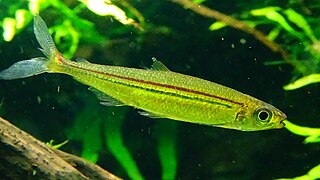
Iguanodectinae is a subfamily of small freshwater fish in the family Iguanodectidae. They are most prominently found in the Amazon river basin and its major tributaries, but they are also known from the Tocantins, Orinoco, and Paraguay rivers. It has two genera, Piabucus and Iguanodectes. Some species in the subfamily are taken from the wild for aquariums, like the red- and green-line lizard tetras. There is minor, but ongoing, debate regarding its taxonomy.
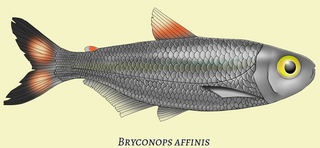
The orangefin tetra is a small species of freshwater fish from South America that belongs to the family Iguanodectidae. Though common in its native range, it seems to prefer fast-flowing and shallow creeks. It is an active swimmer that feeds on plant material and various invertebrates, sometimes jumping out of the water to catch prey above the surface.
Leporinus bleheri is a species of Leporinus widely found in the Iténez-Guaporé River basin in South America. This species can reach a length of 14.2 centimetres (5.6 in) SL.
Phenacogrammus bleheri is a species of fish in the African tetra family. It is known only from a small tributary of the Bari River in the Lua River system in the Ubangi River drainage, in the middle Congo River basin in the Democratic Republic of the Congo. This species reaches a length of 6.3 cm (2.5 in).
References
- ↑ 30 May 1968. TASPO Thalacker Allgemeine, Nr. 22, page 4
- ↑ A. F. H. Bleher. Iténez – River of Hope, 2005, ISBN 88-901816-9-9
- ↑ Neue Presse from 14 July 1953
- ↑ Friederike Tinnapperl. Frankfurter Rundschau, 31 December 2005. Die Frau mit dem Tarzanherzen
- ↑ Bleher, H., 1991. Abschied von Amanda Flora Hilda Bleher, geb. Kiel. Aquarium Heute, Bielefeld, Wien, 4/91: 46–47
- ↑ 4 April 1955. El Mercurio. Familia Alemana Viviò Singular Aventura en Selvas de Brasil
- ↑ Bleher, H., 1987. The Most Spectactular Rummy-nose – An odyssey in search of the fiery Hemigrammus bleheri. Tropical Fish Hobbyist, T.F.H. Publication Inc., New Jersey – U.S.A., April 1987: 10–21
- ↑ Bleher, H., 1989. Die Geschichte des echten Rotkopf-Salmlers Hemigrammus bleheri. Aquarium Heute, Bielefeld, Wien, 1/89: 49–51
- ↑ (Allen, 1980) aus Irian Jaya. Datz, Germany, July: 274–276
- ↑ Tropical Fish Hobbyist Magazine 1986. Collecting the Forktailed Rainbowfish, Popondetta furcata. Tropical Fish Hobbyist, March 1986: 17–27
- ↑ Practical Fishkeeping Magazine 2013. Discoveries: male, Melanotaenia sp. 5, male Pseudomugil cf. inconspicus, male Pseudomugil, cf. paludicola, male Etna Bay Melanotaenia sp. 2. Practical fishkeeping, Emap Active Ltd., Peterbourgh – UK, Issue 10: 98–99.
- ↑ Practical Fishkeeping Magazine 2015. "All the colours of the rainbow". Practical fishkeeping, Emap Active Ltd., Peterbourgh – UK, Issue 11: 70–73.
- ↑ Amazonas Magazine 2011. Aktuelles über "Blattfische". Amazonas Süßwasseraquaristik-Fachmagazin, German, Nr. 42 Juli/August: 14–20 (in German)
- ↑ Nutrafin Aquatic News Magazine 2003. "Fishes in nature and in the aquarium" – Angelfishes and their history. Nutrafin Aquatic News, Italy, Issue #3: 4–6
- ↑ Lima, F.C.T., L.R. Malabarba, P.A. Buckup, J.F. Pezzi da Silva, R.P. Vari, A. Harold, R. Benine, O.T. Oyakawa, C.S. Pavanelli, N.A. Menezes, C.A.S. Lucena, M.C.S.L. Malabarba, Z.M.S. Lucena, R.E. Reis, F. Langeani, C. Moreira et al. …, 2003. Genera Incertae Sedis in Characidae. p. 106-168. In R.E. Reis, S.O. Kullander and C.J. Ferraris, Jr. (eds.) Checklist of the Freshwater Fishes of South and Central America. Porto Alegre: EDIPUCRS, Brasil.
- ↑ Géry, J., 1999. A new anostomid species, Leporinus bleheri n. sp., from the Rio Guaporé-Iténez basin, with comments on some related species (Teleostei: Ostariophysi, Characiformes). Aqua J. Ichthyol. Aquat. Biol. 3(3):105–112.
- ↑ Aarn and W. Ivantsoff, 2009. Description of a new subfamily, genus and species of a freshwater atherinid, Bleheratherina pierucciae (Pisces: Atherinidae) from New Caledonia. Aqua Int. J. Ichthyol. 15(1):13–28.
- ↑ Meyer, M.K., 1993. Description of a new Steatocranus species from Luapula River system, Zaire. Zoologische Abhandlungen, Staatliches Museum Für Tierkunde Dresden 47(9):113–120.
- ↑ Zhang, C.-G., P. Musikasinthon and K. Watanabe. 2002. Channa nox, a new channid fish lacking a pelvic fin from Guangxi, China. Ichthyol. Res 49(2): 140–146.
- ↑ Géry, J., 1995. Description of new or poorly known Alestinae (Teleostei: Characiformes: Alestidae) from Africa, with a note on the generic concept in the Alestinae. Aqua J. Ichthyol. Aquat. Biol. 1(4):37–64.
- ↑ Carvalho, T.P. and V.A. Bertaco, 2006. Two new species of Hyphessobrycon (Teleostei: Characidae) from upper rio Tapajós basin on Chapada dos Parecis, central Brazil. Neotrop. Ichthyol. 4(3):301–308.
- ↑ Allen, G.R., 1991. Field guide to the freshwater fishes of New Guinea. Publication, no. 9. 268 p. Christensen Research Institute, Madang, Papua New Guinea
- ↑ Bromeliaceae Vriesea bleheri Roeth & W.Weber Bradea 2(38): 262. 1978
- ↑ Christopher Scharpf & Kenneth J. Lazara (22 September 2018). "Order CHARACIFORMES: Family CHARACIDAE: Subfamily STETHAPRIONINAE (h-t)". The ETYFish Project Fish Name Etymology Database. Christopher Scharpf and Kenneth J. Lazara. Retrieved 13 March 2022.
- ↑ "Little escapades from city life: Plagiarism – the sickening truth". 28 July 2012.
- ↑ "Shankar Balasubramanian on Facebook". Facebook. Archived from the original on 27 April 2022.[ user-generated source ]